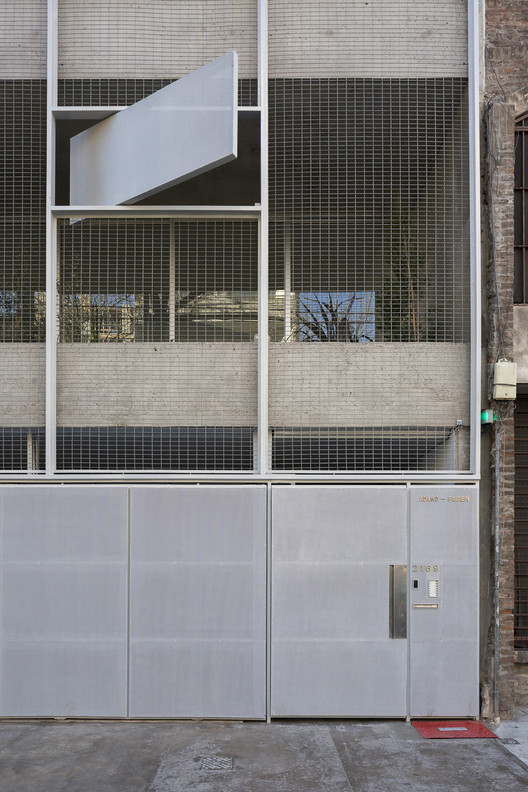House in Azpitia Estudio Rafael Freyre
2015-10-09 11:00
© Edi Hirose
伊迪·伊罗斯


架构师提供的文本描述。这座房子位于秘鲁利马海岸的阿兹皮蒂亚山谷,距利马市以南约90公里,距海滨20公里。当地葡萄园及其前哥伦布遗址所知的地方;一种自然绿洲,供人们逃离大城市利马。
Text description provided by the architects. The house is located in Azpitia valley, in the coast of Lima, Peru. Approximately 90 Km south of the city of Lima and 20 km away from the seashore. A place known by the local vineyards and its pre-columbian ruins; a kind of natural oasis for people escaping from the big metropolis of Lima.
© Edi Hirose
伊迪·伊罗斯


这一景观的特点是沙漠干燥,与马拉河沿线从山脉到太平洋的绿色区域形成鲜明对比。山谷由小山组成的山谷,从河的两边的沙漠中升起,颜色从米黄色变成浅褐色,变成红色、无烟煤和柔和的灰色。房子坐落在山坡上,山脚下,望着马拉河走向大海的小径,面向葡萄园。
The landscape is characterized by the dryness of the desert that contrasts with green areas along the course of the river Mala from the mountains towards the Pacific Ocean. A valley consisting of small mountains and picks rising up from the desert on both sides of the river,cchanging colors from beige to light brown, to reddish, anthracite and soft grey.The house sits on a slope, at the foot of the mountain with a view to the path of the river Mala towards the sea, ¡ facing the vineyards.
Floor Plan
.jpg)

该项目的目的是将房屋与这种干燥的景观相结合,并根据这种环境发展几何和纹理及颜色的调色板。此外,该项目应被视为旧的景观之上的一个新的层面:前哥伦布遗址以及纺织品和陶瓷遗迹。不同时间层次的图像在一起。
The project was intended to integrate the house with such dry landscape and to develop a geometry and a palette of textures and colors according to this environment. Furthermore, the project should be seen as a new layer on the landscape above the old existing ones: the pre-columbian sites and textiles and ceramics remains. An image of different time layers all together.
© Edi Hirose
伊迪·伊罗斯


为此目的,我们决定使用不同的材料层,特别是与本地手工材料和技术,并与其他工业的。在离阿兹皮蒂亚20公里的奇尔卡海岸,我们仍然找到了传统的手工烤炉。砖,由粘土和沙子制成,具有热性质,不规则的纹理和特殊的颜色,与这个干燥的景观有关。
For such purpose we decided to use different materials layers, specially working with local handcrafted materials and techniques, merged with other industrial ones. Twenty kilometers away from Azpitia, at the Chilca shore, we still found traditional local handcrafted brick ovens. The bricks, made of clay and sand have thermal properties, an irregular texture and particular colors that relate to this dry landscape.
© Edi Hirose
伊迪·伊罗斯


房子的基础是由当地石料制成的平台组成,上面覆盖着旱生植物,隐藏着桑拿的内部程序。石层上方是露台:是社交区的延伸-厨房、餐厅和客厅-上面覆盖着一个木屋顶,以防止阳光照射。屋顶是一种纺织网格,允许光线进入。网格是由根据太阳路径发展的木材图案组成的,避免了直接辐射。屋顶,作为一个基本的建筑,创造了一个过渡的空间阴影,半阴影和开放的地区-投射到室外空间的内部生活。整个房子的第一层,包括社会地区,是一个开放的空间,围绕着花园和风景。第二层包括私人区域:主房和副房,都构成了山谷的特殊景观。
The foundation of the house is composed of platforms -made from local stone- covered with xerophyte plants hiding the internal program of the Sauna. Above the stone layer is located the terraces: an extension of the social area -kitchen, dining room and living room- covered with a wood roof that protects form sun radiation. The roof is a kind of textile grid that allows light entrance. The grid is composed from a wood pattern developed according to the sun path, avoiding direct radiation. The roof, as an elementary architectural, creates a transitional space -shadow, semi-shade and open areas- projecting the interior life towards the outdoor space. All the first level of the house, comprising the social areas, is an open space surrounded by gardens and views. The second level contains the private areas: the main and secondary room, both framing special views of the valley.
© Edi Hirose
伊迪·伊罗斯
























.jpg)

.jpg)

.jpg)





Architects Estudio Rafael Freyre
Location Santa Cruz de Flores, Peru
Category Houses
Design Team Luis Bacon, Luis Alberto Mucha, Leonardo Valderrama, Sandro Ocaña, Luis Ocaña
Area 239.0 sqm
Project Year 2014
Photographs Edi Hirose
























